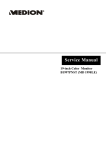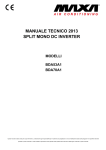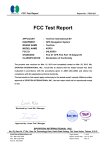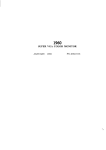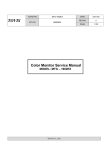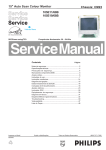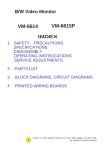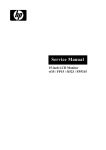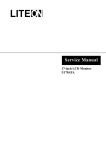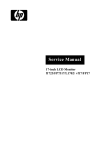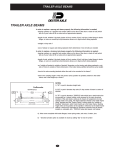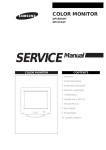Download Medion B1770NSL Service manual
Transcript
MEDION Service Manual 17-inch Color Monitor B1770NSL/T (MD1772LB) Service Manual Versions and Revision No. 1. Ve rsion Re le ase Dat e Re vision 1.0 Aug. 11, 2000 Ori gi nal r el ease Copyright Trademarks Copyright 2000 LiteOn Technology Corp. LiteOn is a registered trademark of LiteOn Technology Corp. All Rights Reserved This manual may not, in whole or in part, be copied, photocopied, reproduced, translated, or converted to any electronic or machine readable form without prior written permission of LiteOn Technology Corp. B1770NSL/NST(99) MD1772LB Service Manual. Printed in Taiwan. All other trademarks are the property of their respective owners. MEDION MD 1772LB (B1770NSL/T) Table of Contents 1. Precautions.........................................................................................................2 2. Product Specifications .......................................................................................5 3 Control Location and Functions ...................................................................... 10 4. Operation Theory.............................................................................................. 11 5. Alignments and Adjustments ........................................................................... 16 6. Troubleshooting ............................................................................................... 21 7. Recommended Spare Parts List ....................................................................... 27 8. Block Diagram ................................................................................................ 29 9. Exploded Diagrams.................................................................................. Inserted 10. PCB Diagrams ......................................................................................... Inserted 11. Schematic Diagrams ................................................................................ Inserted Page 1 MEDION 1 MD 1772LB (B1770NSL/T) Precautions Follow these safety and servicing precautions to prevent damage and to protect against potential hazards such as electrical shock and X-rays. 1-1 Safety Precautions 1-1-1 Warnings 1. For safety purpose, do not attempt to modify the circuit board, and always disconnect the AC power before performing servicing on the monitor. 2. Operation of the monitor outside its cabinet or with the cover removed involves the risk of shock hazard. Repair work on the monitor should only be attempted by service personnel who are thoroughly familiar with all necessary safety precautions and procedures for working on high voltage equipment. 3. Do not lift the CRT by the neck. After completely discharging the high voltage anode, handle the CRT only when wearing shatterproof goggles. Try to keep the CRT away from the body during handling. 4. High voltage should always be kept at the rated value, no higher. Only when high voltage is excessive are X-rays capable of penetrating the shell of the CRT. Operation at high voltages may also cause failure of the CRT or high voltage circuitry. 5. The CRT is especially constructed to limit Xray emission to 0.5mR/HR at 300 microamperes anode current. To ensure continued X-ray protection, replace the CRT with only the same or equivalent type as the original, and adjust the anode’s voltage to the designated maximum rating, never to exceed. nonmetallic control knobs, insulating materials, cabinet backs, adjustment and compartment covers or shields, isolation resistor-capacitor networks, mechanical insulators, etc. 3. AC Leakage Current Check Always perform the AC Leakage Current Check on the exposed metal parts, including metal cabinets, screwheads and control shafts, as follows: a) Plug the AC line cord directly into a rated AC outlet. Do not use an isolation transformer during the check. b) Use an AC voltmeter with at least 5000 ohms per volt sensitivity as follows: Connect a 1500 ohms, 10 watt resistor paralleled by a 0.15uF AC capacitor in series with all exposed metal cabinet parts and a known earth ground, such as electrical conduct or electrical ground connected to earth ground, as shown in the Figure 1-1. Measure the AC voltage across the combination of resistor and capacitor. Figure 1-1. Set Up For AC Leakage Current Check To ex pos ed m e ta l ca bin et p art To kn ow n ea rth g ro un d 0.15 ufd 1500 ohm 10 w att 1-1-2 Safety Checks Before returning the monitor to the user, perform the following safety checks: 1. Inspect to make certain that each lead dress is not pinched or that hardware is not lodged between the chassis and other metal parts in the monitor. 2. Inspect all protective devices such as Page 2 c) Reverse the AC plug at the AC outlet and repeat the steps for AC voltage measurements for each exposed metal part. d) Voltage reading must not exceed 0.3 volts RMS, equivalent to 0.2 milliampere AC. Any value exceeding this limit ill constitute a potential shock hazard and must be corrected immediately. MEDION MD 1772LB (B1770NSL/T) 1-1-3 Product Safety Notices Many electrical and mechanical parts in this chassis have special safety-related characteristics which are often not evident from visual inspection, the protection afforded by them may not be obtained by replacing them with components rated for higher voltage, wattage, etc. Before replacing any of these components, consult the Recommended Spare Parts List given at the end of this manual. Any of the replacements that do not provide the same safety characteristics may result in shock, fire, X-ray emission or other hazards. 1-2 Servicing Precautions Warning: An electrolytic capacitor installed with the wrong polarity might explode. Caution: Before performing servicing covered by this service manual, read and follow the Safety Precautions section of this manual. Note: If unforeseen conflict between the following servicing precautions and any of the safety precautions, always follow the safety precautions 1. Follow closely the servicing precautions printed on the monitor cabinet and chassis. 2. Always unplug the AC power cord from the AC power source before removing or installing any component or assembly, disconnecting PCB plugs or connectors and connecting a test component in parallel with a capacitor. 3. When replacing parts or circuit boards, clamp the lead wires around the component before soldering. 4. When replacing a high wattage resistor (>0.5W metal oxide film resistor) in the circuit board, keep the resistor about 1 cm (1/2 inch) away from the circuit board. 5. Keep wires away from the high voltage or high temperature components. 6. Keep wires in their original positions so as to minimize interference. 7. Always connect a test instrument’s ground lead to the instrument chassis ground before connecting the positive lead; always remove the instrument’s ground lead last. After putting the rear cover back and make sure the monitor is working properly, the Hi-Pot & Ground Continuity tests MUST BE performed before the monitor is returned to user. 1-3 Hi-Pot Test 1. Test Equipment Puncture test model PM5530 ADT or KIKUSU TOS-8750 voltage tester or equivalent approved equipment. Note : The test equipment must be calibrated in regular period. 2. Test Setup a) Apply voltage : DC 2100 VDC b) Test duration : 3 seconds c) Cutoff current should be set to 3 mA 3. Test Procedure a) Unplug power cord from AC source. b) Put the power switch of the monitor in the “ON” position. c) Leave signal cable un-connected. Page 3 MEDION MD 1772LB (B1770NSL/T) d) Plug monitor power cord to the Hi Pot tester terminals. e) Turn on tester and watch the indicator or beeper. f) If the indicator lamp lighten, or beeper beeps, the test fails. 1-4 Ground Continuity Test 1. Test Equipment AC low ohm tester TOS-6100 or equivalent approved equipment. Note : The test equipment must be calibrated in regular period. 2. Test Setup a) Test duration : 3 seconds b) Set current limit at 25 A c) The grounding resistance must be less than 0.1 ohm. 3. Test Procedure a) Plug the monitor power cord to the tester terminals. b) Make sure all connections are well-contacted. c) Turn on monitor power and tester power. d) Press “Test” button. e) If green light shows up, means test OK. If red light shows up, means test fails. f) If the Tester has a digital display, the resistance value must not exceed 0.1 ohm. Note : Be sure not to touch the metal portion of the signal cable head during testing. Page 4 MEDION 2 MD 1772LB (B1770NSL/T) Product Specifications 2-1 Specifications Pi c tur e Tub e 1 7 - i nc h ( 1 5 . 8 - i nc h Vi s ua l i ma ge a r e a) , s l o te d ma s k, 9 0 d e gr e e s d e fl e c ti o n, d o t typ e b l a ck ma tr i x, me d i um s ho r t p e r s i s te nc e p ho s p ho r, d a r k ti nt, no n- gl a r e / a nti - s ta ti c s c r ee n, 0 . 2 7 mm d o t p i tc h Sc a nni ng Fr e q ue nc y VGA, Sup e r VGA, 1 0 2 4 x7 6 8 @6 0 / 7 0 / 7 5 / 8 5 Hz, 1 2 8 0 x1 0 2 4 @6 0 Hz Ma xi mum Re s o l uti o n 1 2 8 0 d o ts ( H) x 1 0 2 4 l i ne s ( V) @6 0 Hz r efr e s h r a te Di s p l a y Ar e a 3 0 0 mm ( H) x 2 2 5 mm ( V) typ i c a l Di s p l a y Cha r a c te r s 8 0 c ha r. x 6 0 r o w s o n a 1 0 x 1 0 ma tr i x Di s p l a y Co l o r s Ana l o g Inp ut Unl i mi te d Co l o r s Sync hr o ni za ti n Si gna l s Se p a r a te S ync : ho r i zo nta l / v er ti c a l , TTL, p o s i ti v e o r nega ti v e Sync hr o ni za ti o n Fr eq ue nc i e s Ho r i zo nta l : Ve r ti c a l : Si gna l Co nne cto r s 1 5 - p i n, D- s he l l co nne c to r Vi d e o Si gna l s Ana l o g : 0 . 7 Vp - p , RGB p o s i ti v e Po w e r Inp ut 11 0 Wa tts ( ma xi mum) AC r a te d v o l ta ge , 1 0 0 VAC to 2 4 0 VAC Mi s c o nv e r ge nce Ce nte r Ar e a : < 0 .3 mm; Co r ne r Ar e a : < 0 . 4 mm Us e r Co ntr o l s 3 0 to 7 0 kHz 5 0 to 1 6 0 Hz Po w e r On/ Off, Co ntr a s t, Br i ghtne s s , Ho r i zo nta l Si ze , Ho r i zo nta l Po s i ti o n, Ve r ti ca l Si ze , Ver ti c a l Po s i ti o n, Pi nc us hi on, Tr a p e zoi d, Ro tati on, Co l o r te mp e r a tur e , La ngua ge , Di s p l a y Fr e q ue nc y, De ga us s , Re c a l l , H. Mo i r e , V. Mo i r e Se r v i c e Co ntr o l s PWB- 1 4 5 2 : R- b i a s ( VR9 0 1 ) , G- b i a s ( VR9 3 1 ) , B- b i a s ( VR9 6 1 ) , PWB- 1 4 5 4 / 1 4 6 8 : p o w e r v o l ta ge a d j us t ( VR8 0 1 ) , hi gh v o l ta ge a d j us t ( VR4 0 1 ) , fo c us 1 , fo c us 2 Pr e s e t Mo d e s 1 3 ( s e e Tab l e 2 - 2 . Ti mi ng Cha r t) Env i r o nme nta l Co ns i d e r ati o ns Note: Op er a ti o n temp e r a tur e : 5 o C to 4 0 o C a mb i ent Op e r a ti o n Humi d i ty : 2 0 % to 8 0 % a mb i e nt Sto r a ge te mp e r atur e : - 4 0 o C to 6 5 o C a mb i ent Sto r a ge Humi d i ty : 5 % to 9 5 % ( no n- co nd e ns i ng) Al ti tud e : up to 3 0 0 0 m a b o v e s e a l ev e l Above specifications are subject to change without prior notice. Page 5 MEDION MD 1772LB (B1770NSL/T) 2-2 Signal Cable Pin Connections Table 2-1. Signal Cable Pin Assignment Pin Signal Pin Signal 1 Red vi de o 9** PC 2 Gr een vi deo 10 Di gi tal Gr ound 3 Bl ue vi de o 11 Gr ound 4 Gr ound 12 SDA 5* NC 13 H- Sync 6 Red gr ound 14 V- Sync / VCL 7 Gr een gr ound 15 SCL 8 Bl ue gr ound Note: * This pin is used for selftest detection. Connect this pin to ground at the PC end. ** For PC99 : this pin will provide +5V from PC side. Page 6 MEDION MD 1772LB (B1770NSL/T) 2-3 Timing Chart This section describes the timings that the computer industry recognizes as standard for computer-generated video signals. Table 2-2. Timing Chart M ode 1 2 3 4 5 6 7 8 9 10 11 12 13 14 H. Dots 720 640 640 800 640 640 800 1024 800 1024 1024 800 1280 1024 V. Dots 400 480 480 600 480 480 600 768 600 768 768 600 1024 768 H-fre q (kHz) 31.47 31.47 35 37.88 37.5 43.3 46.8 48.36 53.67 56.48 60.02 62.966 64.34 68.68 Sync Polarity - - - + - - + + + + + + + + A pe riod us 31.78 31.78 28.57 26.4 26.666 23.111 21.333 20.68 18.63 17.71 16.66 15.876 15.55 14.56 B Blking us 6.356 6.356 7.407 6.4 6.35 5.33 5.172 4.923 4.409 4.053 3.657 4.028 3.589 3.725 C Sync us 3.81 3.81 2.116 3.2 2.03 1.556 1.616 2.092 1.138 1.813 1.219 1.185 0.972 1.016 D B.P. us 1.907 1.907 3.175 2.2 3.81 2.222 3.232 2.462 2.702 1.92 2.235 2.37 2.248 2.201 E Active us 25.42 25.42 21.164 20 20.32 17.778 16.162 15.75 14.22 13.65 13 11.848 11.96 10.836 F F.P. us 0.636 0.636 2.116 1 0.51 1.556 0.323 0.369 0.569 0.32 0.203 0.473 0.374 0.508 V-fre q (Hz) 70.08 59.95 66.667 60.32 75 85 75 60 85 70.07 75.03 99.472 60 85 Sync Polarity + - - + - - + + + + + + + + O Pe riod ms 14.27 16.68 15 16.58 13.33 11.764 13.333 16.67 11.76 14.27 13.33 10.05 16.67 11.77 P Blking ms 1.557 1.43 1.286 0.739 0.533 0.67 0.533 0.786 0.578 0.673 0.533 0.544 0.642 0.582 Q Sync ms 0.064 0.064 0.086 0.106 0.08 0.069 0.064 0.124 0.056 0.106 0.05 0.048 0.047 0.044 R B.P. us 1.08 1.02 1.14 0.607 0.427 0.578 0.448 0.6 0.503 0.513 0.466 0.48 0.501 0.524 S Active us 12.71 15.25 13.714 15.84 12.8 11.093 12.8 15.88 11.18 13.6 12.8 9.526 16.03 11.18 T F.P. us 0.413 0.35 0.086 0.026 0.026 0.023 0.021 0.062 0.019 0.053 0.017 0.16 0.094 0.015 S ep era te S y n c H o rizo n tal B Vid e o D K Vertic al E J F L Sync Sync C I A H.Parameters: H Vid e o G V.Parameters: A: Period B: Blanking Time G: Period H: Blanking Time C: Sync Width D: Back Porch I: Sync Width J: Back Porch E: Active Time F: Front Porch K: Active Time L: Front Porch Page 7 MEDION MD 1772LB (B1770NSL/T) 2-4 Display Power Management Signal (DPMS) Note: These power-saving states exceed the Environmental Protection Agency (EPA) Energy Star requirements and the Video Electronics Standard Association (VESA) for Display Power Management Signal (DPMS) . Table 2-3. Display Power Management Signal (DPMS) State LED Co lo r H- S y nc V- Sy nc Po we r Co ns umpt io n ON Gr e e n P ul s e P ul s e No r ma l S TANDBY Ye l l o w No P ul s e P ul s e <1 5 w a tts S US P END Ye l l o w P ul s e No P ul s e <1 5 w a tts OF F Amb e r No P ul s e No P ul s e <5 w a tts 2-6 TCO Version (Optional) The monitor meets the TCO 92, NUTEK energy saving, electric and magnetic field requirements. Also it is compliant with TCO 95/TCO 99 labelling scheme. 2-6-1 TCO 92 Version (Optional) The emission from magnetic and electric field must comply with the limits specified by the Swedish Board for Measurement and Testing, commonly known as MPR 1990 recommendations. These limits are summarized in the Table 2-4. Table 2-4. TCO 92 Requirements VL F /T C O E L F /T C O M a g n e t ic F ie ld 2 5 nT 2 0 0 nT E le c t r ic F ie ld 1 V/m 1 0 V/m F r e q ue nc y R a nge 2 ~ 4 0 0 k Hz 5 ~ 2 0 0 0 Hz Va lu e RM S RM S D is t a n c e 30 cm 30 cm E le c t r o s t a t ic P o t e n t ia l + /- 5 0 0 V + /- 5 0 0 V The monitor is designed with selected CRT and carefully routed wires around CRT, make sure exactly the same routing scheme is used when doing CRT replacement. Page 8 MEDION MD 1772LB (B1770NSL/T) 2-6-2 TCO 95 Version (Optional) The TCO 95 scheme is for international and environmental labelling of personal computers. The labelling scheme was developed as a joint effort by the TCO (The Swedish Confederation of Professional Employ ees), Naturskyddsforeningen (The Swedish Society for Nature Conservation) and NUTEK (The National Board for Industry and Technical Development in Sweden). 1)`Scope TCO 95 touches on ergonomic qualities, emissions (electrical and magnetic fields), energy efficiency and ecology (with demands for environmental adaptation for both the product and the production processes at the manufacturing plant). 2) Environmental Requirements The monitor abides by the environmental demands concerning restrictions on the presence and use of heavy metals, brominated and chlorinated flame retardants, CFCs (freons), and chlorinated solvents, among other things. The monitor is also recyclable. 3) Energy Requirements The monitor also follows the energy requirements that, after a certain period of inactivity, the monitor shall reduce its power consumption to a lower level in one or more stages. 4) Others The monitor meets the strict environmental demands for the reduction of electric and magnetic fields, physical and visual ergonomics and good usability. Table 2-5. TCO 95 Visual Ergonomics Fe a t ur e St a nda r d D e s c r ip t io n L in e a r it y 1 % o r le s s D if f e r e n c e in le n g t h o f c o lu mn s o r r o w s c o mp a r e d t o t h e c o r r e s p o n d in g le n g t h s t h r o u g h t h e c e n t e r o f t h e mo n it o r . D is p la y L u min a n c e 1 0 0 c d / m2 ( a t le a s t ) L u min a n c e U n if o r mit y 1 . 7 :1 o r le s s T h e r a t io is b e t w e e n t h e ma x t o min lu min a n c e w it h in t h e w h o le a c t iv e a r e a . 2-6-3 TCO 99 Version (Optional) TCO 99 will append the color temperature specification. Page 9 MEDION 3 MD 1772LB (B1770NSL/T) Control Location and Functions (1) (2) (3) (4) (5) (6) (1) (2) (3) (4) (5) (6) Function Key Decrease Key Increase Key Select Key Power LED Power ON/OFF 3-1 Front Panel 3-2 Front Panel Keys Functions 1. Function Key: Display the main menu, and exit the adjustment screen and save adjustments. 2. Decrease Key: Scroll across main menu, highlighting control to be adjusted. Decrease value of selected control. Toggle between Contrast and Brightness adjustment screens. 3. Increase Key: Scroll across main menu, highlighting control to be adjusted. Increase value of selected control. Toggle between Contrast and Brightness adjustment screens. 4. Select Key: Press once to display adjustment screen. Press again, for some controls, to toggle between controls shown in pairs on main menu. 5. Power LED: Display different modes (ON, Standby, Ssuspend or OFF) of the monitor by showing different color for each mode. 6. Power ON/OFF: To turn the monitor ON and OFF. 3-3 Adjustment Procedure 1. Press (6) key to turn on the monitor. 2. At normal condition, press (1)on the front panel to activate the on-screen manager (OSM) menu. 3. To select a user control, press (2) or (3) key repeatedly until the control is highlighted. 4. To adjust the value for a particular control, press (4), then press the (2) or (3) key to obtain the desired value. There are a few parameters that do not require any adjustment, like Manual Degauss, Memory Recall. 5. Some controls are grouped in pairs on the main menu. Press (4) key to toggle between them. 6. To save your adjustments and exit screen, press (1) key. The menu will automatically clear out from the screen if no keys are pressed within 30 seconds. Note: To enter the “Internal Adjustment” mode, press (1) & (4) keys simultaneously then press (6). Page 10 MEDION 4 MD 1772LB (B1770NSL/T) Operation Theory This is a fully digital controlled multi-sync color monitor that is compliant with DDC1/2B Plug and Play VESA standard and offers the following main features. 4-1 Main Features 1. Simplified design with minimum components. 2. The NOVATEK NT68P61AU processor-- that has I2C bus controlled geometric correction, contrast and brightness-- offers the functions for: (a) Contrast, (b) Brightness, (c) H-size, (d) H-position, (e) V-size, (f) V-position, (g) Pincushion, and (h) Trapezoid. In addition, it also offers more functions as: (a) Sync. processor, I/P and O/P, (b) Mute, (c) Power saving - Suspend & Stand-By, (d) Power saving override, (e) DDC1/2B, (f) I2C Bus for auto-alignment through signal cable (g) CS1 switching for linearity and size compensation. 3. Stores up to 14 factory preset modes and offers 7 user modes. There are 16 function icons in OSD. They are controlled by 1 2 keys on the front panel. 4. Powerful PHILIPS TDA4856 and TDA4866 present the following useful functions: (a) Pincushion, (b) Trapezoid, (c) V-Position, (d) V-Size, (e) Vertical’s “C” and “S” correction -- factory adjust, (f) Pincushion’s V. position correction, (g) Corner correction -- factory adjust, (h) Pincushion unbalance correction -factory adjust, (i) Parallelogram distortion -- factory adjust, (j) Moire cancellation -- factory adjust, (k) Xray protection, and (l) Full horizontal and vertical auto sync capability. 5. Software controlled auto shut off function activated if fH < = 29 kHz and fH > = 73 kHz. 6. Full range AC input and simplified line filter design. 4-2 Microcontrol Section 1. This monitor uses NOVATEK NT68P61AU CPU. It contains a 6502 8-bit CPU core, 256 bytes of RAM used as working RAM and stack area, 24k bytes of OTP ROM, 14-channel 8 bit PWM D/A converter, 2channel A/D converters for key detection saving I/O pins, internal H. sync and V. sync signals processor providing mode detection, and an I2C bus interface. When H/V sync through D-Sub signal cable enter pin 41 and pin 42, the CPU performs frequency / polarity detection and calculate and send to H/V sync OUT. Then CPU reads the data from I703 and transfer to device 4856 and some DAC in CPU, above operation takes about 500 ms. 2. There allows 14 factory preset modes and 7 user modes. There are 8 functions, Contrast, Brightness, H. Size, H. Position, V. Size, V. Position, Pincushion, and Trapezoid, all controlled by OSD icon which can be adjusted by user. 3. The pin 25 and pin 26 are used for ATE function. When CPU receives C6 as slave address, it will operate in ATE mode which is used for auto-alignment. After alignment the data will be stored in I703. 4. The user control parameters are selected by OSD icons, through 1 & 2 keys, they are detected by sensing the voltage through R710, R740, R711, R743, R741, R742 to pin 14 and 15 of I701. 4-3 Deflection Section 1. I2C -- autosync deflection controller is TDA4856. 2. The TDA4856 is a high performance and efficient solution for autosync monitors. All functions are controllable by I2C bus. SDA and SCL signals coming from microprocessor feed to pin 19 and pin 18 to control all functions. Page 11 MEDION MD 1772LB (B1770NSL/T) 4-3-1 Horizontal Section 1. The oscillator is driven by the currents in R467 and R468. The minimum oscillator frequency is determined by R467 and the maximum frequency is determined by R468. 2. Horizontal sync goes into pin 15 through R494. And horizontal flyback pulse goes into pin 1 through R479 and bypass filter C446 from Emitter of Q403 and C406, C407, C461, R407, D432, R404, R402 for AFC loop. 3. Horizontal driver (pin8) output to Q401 via C403, Q401 switching to drive T401 provide IB1/IB2 current then turn on/off Q402 and switching the yoke current. 4-3-2 Vertical Section 1. Vertical sync goes into pin 14 through R493. 2. The free running frequency is determined by R470 and C441. 4-3-3 Vertical O/P section 1. The differential output currents from pin 13 of Vout1 and pin 12 of Vout2 can be directly coupled to the vertical deflection booster pin 1 and pin 2 of TDA4866. 2. The TDA4866 has two output stages which are current driven in opposite phase and operate in combination with the deflection coil in a full bridge configuration. 3. This IC is powered by two sets of positive voltage. (+12.5V at pin 3, +48V at pin 7). 4-3-4 E-W/Trapezoid and H. Width Controls 1. The scan current is determined by B+ (the voltage of C410) that is obtained from step-up circuit output. Step-up circuit include Q405, R414, T403, D407, R411, R412. 2. I401 TDA4856 pin 6 (B DRV) will drive the step-up circuit to change H. width. 3. EW DRV (pin11) provides a complete EW drive waveform including parabola, corner and trapezoid correction and feed to BIN (pin 5 of I401) to get a good control for pincushion / trapezoid / corner. 4. The top and bottom corner correction can be adjusted seperately. 4-3-5 X-Ray Protection 1. To avoid X-ray hazard, a DC voltage generated at pin 6 of FBT and rectified by D417, C431 and divided by R476, R477 and R478 come into pin 2 of TDA4856. 2. If this voltage is higher than 6.39 V, then TDA4856 will be activated to float HUNLOCK (pin17), H. DRV ( pin 8), B DRV (pin 6), VOUT1 (pin 12), VOUT2 (pin13). After that all deflection circuit stop working. 4-3-6 G1, Blanking and Brightness 1. The vertical blanking signal comes from two ways. One is from pin 8 of I301 (TDA4866), the other is from vertical sync (pin 33 of I701). These two positive vertical pulses through Q421 amplified and converted into negative pulse and sent to G1 for vertical blanking. 2. In protection mode or an out-of- range situation HUNLock will send 5 V pulse to saturate Q429 and cutoff Q420, then G1 will go down to -130V. During the mode change, Mute acts as same as HUNLock’s. 3. The brightness is controlled by CPU pin 3 through PNP transistor Q420. Q420 is a switch in conducted (ON) status normally. The lower or higher control voltage will get low brightness or high brightness. Page 12 MEDION MD 1772LB (B1770NSL/T) 4-3-7 Contrast Section 1. Contrast is controlled by I701 through I2C bus to I501 (TDA4886) directly. 2. Beam current is detected through T402 (FBT) pin 7, C432, Q418, VR402, R453, Q419 and detected voltage feeding into R510, R509, R507,C523 to control I501 pin 24 voltage. When I501 pin 24 voltage drops below 5V, the ABL function will happen. 4-3-8 Dynamic focus circuitry The dynamic focus is applied to improve the corner focus performance, it includes horizontal and vertical dynamic focus. 1. Horizontal and vertical dynamic comes from I401 pin 32 and is amplified through C427, R450, Q416, Q415, Q414, R498 and feed to FBT dynamic focus pins. 2. This amplifier need 700V voltage supply, it comes from FBT pin 2 and rectified through L406, D414 and C426. 4-4 Power Supply Section 4-4-1 AC Rectifier The circuit can accept 90 V to 264 V AC input through D801~D804 bridge diodes and C808 filtering to get DC 126 V~364 V for power conversion in T802. 4-4-2 Line Filter It consists of C801, C802, C803, C816, C820, C823, C807 and T801 and meets EMI regulation. 4-4-3 Power LED Status 1. The LED has 3 leads with common cathode to emit green and amber color light for different power saving states. It is controlled by CPU. 2. Normal : Green light Amber LED is off because CPU pin 18 is high and pin 17 is low, only green LED is turned on. 3. Standby / Suspend : Yellow light CPU pin 17 and pin 18 are low, then green and amber LED are turned on. That is yellow. 4. Off Mode : Amber light CPU pin 17 is high and pin 18 is low, then green is off and amber is illuminated. 4-4-4 Auto Degaussing When S801 turns on, pin 10 of I701 will send a signal to Q802 and turns on RL801 for degaussing. After 4 seconds, it will turn off RL801 automatically. 4-4-5 PWM Control 1. Start Up The I801 (MC3842) gets power from R831, R830, C812 and pin 7 voltage reaches 16 V for starting up. The I801 starts oscillation at 22 kHz, sawtooth on pin 4 and pin 6 output to drive Q803/T802. Once Q803 switching on, D806, C804 set up an 15 V to keep I801 working through D821 auxiliary voltage. Page 13 MEDION MD 1772LB (B1770NSL/T) 2. Regulation The DC O/P voltage is proportional to the auxiliary voltage, so I801 pin 2 senses the feedback voltage from the divider R802, R823, VR801 and R821 to compare with the built-in 2.5 volts reference voltage for error amplifier operation. Finally pin 6 can modulate the different duty cycle by VR801 setting to achieve regulation purpose. 4-4-6 Synchronization 1. Normal Mode The sync pulse from FBT (31 kHz~69 kHz) via C815, R826, D824, C814 and R816 to pin 4 of I801 to keep I801 synchronized with horizontal sync input frequency. 2. Power Saving Modes: Standby/Suspend Because there is no pulse from FBT, so the free-run frequency is decided by R816 and C814 and the SMPS works at 22 kHz. 3. Override The horizontal free run frequency is about 62.5 kHz under override condition, SMPS is synchronized to this frequency. 4-4-7 O.V.P. If the auxiliary voltage is higher than zener voltage ZD807 (18 volts) and makes pin 3 of I801 higher than 1 V, pin 6 duty cycle is limited to have the OVP activated. 4-4-8 O.P.P. The excess current of T802 through R813, R865 and R864 can develop enough voltage on pin 3 then limit the power delivered because the pin 6 duty cycle is limited too. 4-4-9 High Voltage Generation with F.B.T. 1. The H. V generation circuit combines T402 F.B.T. with I402 TL494/KA7500 PWM control circuit. 2. When I402, Vcc(pin12) reaches at 5V, pin 5,6 gets a freerun sawtooth waveform about 25KHz, and approximately 9.5Vp-p, when voltage at pin 15 is higher than pin 16 (5V reference) then release pin 3 to be controlled by pin 1 feedback signal and compare with pin 5 to output PWM. 3. HFLB1 is used will trigger pin 5 via Q412, to synchronize the deflection circuit. 4. PWM output to drive Q411 and T402 to gererate high voltage (25KV), T402 pin 11, 12 becomes DC/AC feedback, with the voltage link to I402 non-inverting input pin 1 to stabilize H.V (25KV) and VR401 can be adjusted to control H.V value. 5. When X.R.P occur, the hunlock will keep high to pull down I402 pin 2 and shut down PWM output. 4-5 Video Amplifier Section 1. RGB signal inputs are terminated by R525, R526 and R527 then pass through the coupling capacitors C502, C504 and C506 to IC501 TDA 4886 preamplifier. 2. The amplifier RGB signals (0~3 Vpp) are adjusted by I2C bus from I501, pin 5 is for clamp pulse which comes from pin 16 of TDA4856 to set up equal clamp level. 3. The video output stages are amplified by Q963, Q964, Q903, Q904, Q933, Q934, Q962, Q965 Q902, Q905, Q932, Q935.4. The RGB cathodes cut off are adjusted by VR961, VR901 and VR931. Page 14 MEDION MD 1772LB (B1770NSL/T) 5. Under override condition, “CHECK SIGNAL” will show up on the screen. 4-6 OSD (On Screen Display) Circuit 1. The I502 HTV021-02 is OSD IC. The OSD signals are worked by positive vertical pulse from I701 pin 32 that goes through R521 to I502 pin 10, and positive horizontal pulse from HFLB1 through R513 to I502 pin 5. CPU I701 pin 27, 28 (I 2C bus) transfers information to I502 pin 7, 8. 2. The OSD R. G. B signals and blanking signal are terminated at I502 pin 15, 14, 13, and 12 to I501 pin 2, 3,4, and 1, then the OSD picture appears. Page 15 MEDION 5 MD 1772LB (B1770NSL/T) Alignments and Adjustments This section of the service manual explains how to make permanent adjustments to the monitor settings. 5-1 General Adjustments 5-1-1 Adjustment Conditions a) Power Supply Apply AC 115 V or 220 V b) Warm-up Time The monitor must be powered on for 15 minutes before starting any alignment, but requires 30 minutes of warm-up time for convergence adjustment. c) Signal Input 1. Video: RGB Analog, 0.7 Vp-p, positive 2. Synchronization: Horizontal and vertical TTL signal, separate, positive or negative 3. All adjustments should be made using a signal of FH = 68 kHz, FV = 85 Hz, unless otherwise defined. 5-1-2 Equipment Required The following equipments are necessary for adjustment procedures: 1. Volt-ohm-A meter (Sanwa FD-750C or equivalent) 2. 30 kV high voltage probe (HP34111A) 3. Oscilloscope (TEK2235 or equivalent) 4. Minolta Color Analyzer II 5. Signal generator (IBM PC with proper display cards or Chroma 2000) 6. Screwdriver 5-1-3 Switching Power Supply and Regulator Adjustment a. The regulated B+ control has been preset in the factory and needs no adjustment. However, if any repair is made on the power supply section, the following readjustment procedures are recommended: 1. Allow the monitor to warm-up for about 15 minutes. 2. Apply XGA (1024 x 768 @ 68 kHz/85 Hz) signal to the monitor. 3. Connect a DC voltage meter to R512-TP001 end, and adjust VR801 for 12.5 + 0.2 V DC 4. If a fuse is broken during adjustment, remember to replace it with the exact same type of fuse. b. If necessary, follow the following procedures to enter the factory mode. 1. Press both 1 key and 2 key simultaneously then power ON. 2. After turn the power off, monitor will go back to normal mode. 3. When you use ATE adjustment fixture, you should switch S705 to ATE (Factory) position, after you finish the adjustment, please switch S705 to DDC (normal) position to return to normal mode. Page 16 MEDION MD 1772LB (B1770NSL/T) 5-2 Alignment Procedures 5-2-1 High Voltage Adjustment CONDITION Display image : Crosshatch pattern PROCEDURE Connect DC meter to TP5 and adjust VR401 to obtain a DC voltage of -130 ± 0.2 V DC. 5-2-2 Screen and White Balance Adjustment CONDITION Press 1 and 2 buttons simultaneously when switching the power “On”. Bias VRs : VR961, VR901, VR931 Display image : No video PROCEDURE 1 Raster color setting 1-a. Set Brightness through OSD menu to -40 V at G1 and 560 V at G2. 1-b Adjust VR961, VR901 and VR931 to maximum. 1-c Adjust VR931 to raster just distinguish. 1-d Set Brightness to maximun. 1-e Adjust VR901 to get x=280 ± 5 and VR961 to get y=280 ± 5, brightness = 0.9 ~ 1.2 FL. 1-f Adjust Brightness to cut-off. CONDITION Display image : 50 mm x 50 mm white block pattern PROCEDURE 2 65000K color temperature setting 2-a. Set Brightness to cutoff and Contrast to maximum. 2-b Move cursor on OSD to choose color temperature icon. 2-c. Press 2-d Check x=313±5, y=329±5. 3 93000K color temperature setting 3-a. Set Brightness to cutoff and Contrast to maximum. 3-b Move cursor on OSD to choose color temperature icon. 3-c. Press 3-d Adjust contrast to set Y=38±2FL 3-e Check x=281±5, y=311±5. 3-f TCO99-model 9300OK color temperature setting y=297±5, x=283±5. 4 Full white ABL setting 2 2 key to G gain then adjust G gain = 68 value, then adjust B, R to y=329±5, x=313±5. key to G gain then adjust G gain = 85 value, then adjust B, R to y=311±5, x=281±5. CONDITION Display image : full white pattern 4-a Set Brightness to cutoff and Contrast to maximum. Page 17 MEDION MD 1772LB (B1770NSL/T) 4-b. Adjust VR 402 to Y=29.5FL ± 1FL. 4-c. Check the white balance at 5FL and 28FL. 4-d. Repeat all the procedures in 5-2-2 section until the best white balance is obtained 5-2-3 Focus Adjustment CONDITION Display image : “e” character pattern PROCEDURE 1. Set Brightness to cutoff and Contrast to maximum. 2. Adjust top VR at T402 (static focus VR) to make vertical line clear. 3. Adjust center VR at T402 (dynamic focus VR) to make horizontal line clear. 4. Repeat above procedures to get best focus. 5-2-4 Dynamic focus Adjustments 1. Horizontal dynamic focus set Hf=300V in phase (compare with Vcp signal). 2. Vertical dynamic focus set Vf=160V in phase. 5-2-5 Static Convergence Adjustments Static convergence involves alignment of the red, blue and green lines in the center area of the display. Note : The monitor requires 30 minutes warm-up time for convergence adjustment. CONDITION Display image : Crosshatch pattern Warm-up Time : 30 minutes PROCEDURE 1. Set Brightness and Contrast to display a well-defined pattern. 2. Ensure the convergence magnet rings are correctly positioned on the CRT. Page 18 MEDION MD 1772LB (B1770NSL/T) Figure 4-1. Convergence Magnets on the CRT 1 11 + P CRT FRONT 9 87654 10 3 2 1) Setup Bolt 2) Bow Magnet 3) Band 4) 2-Pole Magnet 5) Spacer 9) Holder 6) 4-Pole Magnet 10) Band 7) Spacer 11) Tabs 8) 6-Pole Magnet 3. Rotate the individual rings of 4-pole convergence magnets by changing the spacing between the 2 tabs to converge the vertical red and blue lines at the center of the screen. 4. Rotate the pair of rings of 4-pole convergence magnets by maintaining spacing between the 2 tabs to converge the horizontal red and blue lines at the center of the screen. 5. Rotate the individual rings of 6-pole convergence magnets by changing the spacing between the 2 tabs to converge the vertical red, blue and green lines. 6. Rotate the pair of rings of 6-pole convergence magnets by maintaining spacing between the 2 tabs to converge the horizontal red, blue and green lines. 7. Repeat the steps from 3~6 until the best convergence is obtained. Figure 4-2. 4-pole and 6-pole Magnets Movement Blue Blue Red/ Blue Red Green 4-pole m agnets m ovem ent Note : Red/ Blue Red G reen 6-pole m agnets m ovem ent The 4-pole magnets and the 6-pole magnets interact, making dot movement complex. Page 19 MEDION MD 1772LB (B1770NSL/T) 5-2-6 Degaussing Degaussing is required when poor color impurity appears on the screen. This monitor uses an automatic degaussing circuit that is activated when the power is on. The automatic degaussing will be fully functional again after the monitor has been in operation for 20 minutes. The degaussing effect is confined to the picture tube since the coils are mounted at the back of the tube. Should any part of the chassis or cabinet becomes magnetized, it is necessary to degauss the affected area with a manual degaussing coil. 5-2-7 Manual Degaussing 1. Apply line voltage to the degaussing coil and move it in a rotary motion over the front, sides, and top of the monitor. The coil should be kept away from the rear of the monitor to avoid damaging the magnetic neck components. 2. Slowly rotate and move the coil away from the monitor to about 6 feet beyond the point where no effect on the CRT will be noticeable. For proper degaussing, it is essential that the field be gradually reduced by moving the coil slowly away from the monitor. The degaussing coil must never be shut off or disconnected while near the monitor, as this would introduce a strong field instead of canceling the effect of the stray fields. Page 20 MEDION 6 MD 1772LB (B1770NSL/T) Troubleshooting 6-1 No Raster No Raster Measure voltage of B+ at T402 pin 3 on PWB-MAIN 0V Short Circuit at load? No Normal (68 V, 31.5 kHz) High (75 V or more) Check voltage of cathode, heater, Grid 1, Grid 2, etc. Check I401 Yes Check DC B+ line, Q411, D817 Check AC I/P on C808 No Yes Check I801, Q803, R814, R813, ZD807, ZD801, R831, R830, R818 Check D801, D802, D803, D804, T801, R804, F801 Page 21 MEDION MD 1772LB (B1770NSL/T) 6-2 OSD Abnormal OSD Abnormal Check I502 missing? Yes Put on I502 No Check R530, R532, R531 OK? No Replace them No Replace it Yes Check JP806, L504, L505 OK? Yes Replace I502 Page 22 MEDION 6-3 MD 1772LB (B1770NSL/T) Function Key Abnormal Function Key Abnormal Check I701 and I703 missing? Yes Put on I701, I703 No Power ON/OFF again and check X701, oscillator OK? No Replace X701 No Replace I703 or do ATE again Yes Replace I701 Yes Check R735, C710 Yes Check I703 EEPROM content OK? Yes Replace I701 and check uP OK? No Check pin 5 of I701 is 5V? No Replace I804 Page 23 MEDION MD 1772LB (B1770NSL/T) 6-4 No Vertical Scan (Raster is one horizontal line) No Vertical Scan Check I301 voltage of pin 3 is 12V, pin 7 is 48V? No Ckeck or replace I301. Abnormal Replace I301 Yes Check pin 6 O/P waveform at I301 Normal Check pin 1, 2, 9 of I301 waveform Still no vertical scan Check or replace CRT Page 24 MEDION MD 1772LB (B1770NSL/T) 6-5 Out of Horizontal Synchronization Out of Horizontal Synchronization Horizontal sync present at pin 15 of I401 No Ckeck or replace the signal cable or I701 No Check or replace the signal cable or I701 No Ckeck signal cable & vertical sync input & I701 Yes Check I401 pin 8 H output frequency Yes Check Q401, T401, Q402, R4A6, D402, R403, D402 6-6 Out of Vertical Synchronization Out of Vertical Synchronization Vertical sync present at pin 14 of I401 Yes Check I401 pin 24 ramp frequency Check C441 Page 25 MEDION MD 1772LB (B1770NSL/T) 6-7 R.G.B. Video Amplifier Abnormal RGB Video AMP Abnormal Check waveform at I501 pin 16, 19 and 22 No Check or replace the signal cable or I501 No Check Q964, Q904, Q934 Yes Check Q963, Q903, Q933 collector voltage and wave form Yes Video signal present at the pin of the CRT R.G.B. Cathode Yes Defective cut-off circuit (DC restore) Page 26 MEDION 7 MD 1772LB (B1770NSL/T) Recommended Parts List Note: 1. 2. The components identified by “ the same parts specified. “ mark are critical for X-ray safety. Replace these with only There is only OTP IC at the model beginning (FPR stage or before). When it put in mass production and there must be Mask coming out. If you have spart parts need, please use BOM to get the last release part number and related information. No. Location Part Number Description 1 C407 6326315446 MPP uF 0.15 400V H F P=15 HJC 2 C808 6312622126 ALU uF 220 400V F 85C 25x40 3 D801 D802 D803 D804 6412011307 DIODE 1N5406 T52 3A/600V 4 D814 6412017900 DIODE RL3 3.5A/350V SANKEN 5 D815 6412004117 DIODE UF2004M T52 2A/400V 50nS 6 D429 D407 6412020203 DIODE HER305 BXF 3A/400V 7 F801 6851004050 FUSE TIME LAG 5ST4 4A/250V 8 I301 6442012300 IC TDA4866 9P (PHILIPS) 9 I401 6442025200 IC TDA4856 32P SDIP (PHILIPS) 10 I501 6442021500 IC TDA4886 24P SDIP (PHILIPS) 11 I701 6448014500 IC NT68P61AU 40P PDIP OTP NOVAT 12 I703 6448007930 IC 24C04 SAMSUNG 13 I801 6442022000 IC KA3842AC 8P PDIP (SAMSUNG) 14 I901 6442025600 IC LM2437 9P TO-220 NS 15 L403, L411 6111254130 COIL CHOKE 2.5mH K DRWW 16 Q402 6421004410 TR NPN 2SC5386 (TOSHIBA) 17 Q405 6426006300 FET N-CHNL IRFS634A 18 Q411 6426009400 FET N-CHNL IRFS830A 19 Q413 6426006400 FET N-CHNL IRFS630A SAMSUNG 20 Q803 6426006700 FET N-CHNL SSS7N60A SAMSUNG 21 R803 6203090002 POSISTOR 9 OHM Q 2PINPITCH=10 Page 27 MEDION No. MD 1772LB (B1770NSL/T) Location Part Number Description 22 R804 6201100012 THERMISTOR 10 OHM 3A P=5 TKS 23 R818 6220327852 FS OHM 0.27 1W J HOR 24 T401 6135000801 XFRMR HOR DRIVE THD-1008A EI19 25 T402 6133070120 FBT TFB-7012 FEA867 SAMPO 26 T403 6111155174 COIL CHOKE 150 uH 27 T801 6138001601 LINE FILTER TLF-1016A 16mHET28 28 T802 6131060820 XFRMER PWR TPW-1070 EI40 29 X701 6449000719 CRYSTAL 8MHz TOP8.000 30pF TOP 30 D813 D817 6412000520 DIODE RL4A 3A/600V 50nS SANKEN Page 28 MEDION G R911, R912, Q903, Q904, Q902, Q905 Q901 R BUFFER & DC RESTORE R941, R942, Q933, Q934, Q932, Q935 Q931 G BUFFER & DC RESTORE R G B HEATER G1 G2 FOCUS 1 Q961 B BUFFER & DC RESTORE FOCUS 2 VIDEO AMP R971, R972, Q963, Q964, Q962, Q965 4V GND B P901 GND Block Diagram GND R GND GND 130V 12V 80V 6.3V G1 P903 130V SDA1 I402 PWM CONTROL TL494/KA7500 SCL1 I501 TDA4886 VIDEO PREAMP Q411 FBT DRIVER 48V -130V ABL T402 FBT Q413 CANCELING CKT B R G 8V R G B G2 CONTROL VR ABL CONTROL CKT Q418, Q419 5V (OSD) P501 R-IN G-IN SDA 1 I502 MTV021-21 OSD B-IN SCL 1 SCL SDA HFLB1 HFLB1 VTTL H DRIVER Q402 D403 C406 CLBL O/R VTTL SCL HTTL T401 TDA 4856 SCL1 SDA DDC 5V BRIGHTNESS CONTROL B+ DRIVER Q405 T403 LINEARITY CONTROL L404, L405 +V -V 45V 12V I701 NT6861 AU LED P301 +H XRP RESET CKT R735 C710 H SYNC BRIGHTNESS CONTROL& SPOT KILLER -H VOUT 1 VOUT 2 SDA1 V SYNC H CENTER Q406 VR403 8V REGULATOR I503 XRP CKT 5V REGULATOR QI804 KEY CONTROL S705 OFF FACTORY ATE SCL NORMAL DDC SCL SDA I702 24C21 SCL1 SDA1 SDA STAND-BY DEG. 8 MD 1772LB (B1770NSL/T) 48V E 2P R O M I703 2404 VERTICAL O/P I301 12V DEG CKT LINE FILTER 80V BRIDGE DIODE SMPS POWER 45V O/P T802 12V 7V LOW VOLTAGE DROP DOWN Q811 7V SWITCH 12V SWITCH Q813 Page 29 MEDION LITE-ON TECHNOLOGY CORP. 5 F, No. 16, Sec. 4, Nanking E. Road, Taipei, Taiwan Tel: 886-2-25706999 Fax: 886-2-25706888 URL:// www.liteontc.com.tw Printed in Taiwan
































